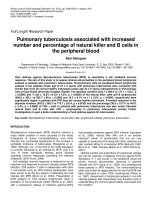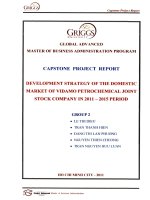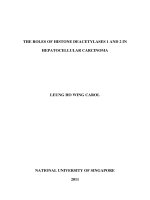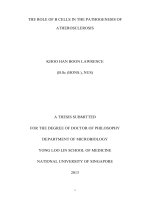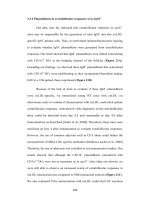The accessory roles of lipopolysaccharide activated murine b cells in t cell polarization
Bạn đang xem bản rút gọn của tài liệu. Xem và tải ngay bản đầy đủ của tài liệu tại đây (3.18 MB, 250 trang )
THE ACCESSORY ROLES OF LIPOPOLYSACCHARIDE-
ACTIVATED MURINE B CELLS IN
T CELL POLARIZATION
XU HUI
(MD, Peking University Health Science Center, PRC)
A THESIS SUBMITTED
FOR THE DEGREE OF DOCTOR OF PHILOSOPHY
DEPARTMENT OF PAEDIATRICS
NATIONAL UNIVERSITY OF SINGAPORE
2008
i
Acknowledgements
First and foremost, I would like to thank my supervisor, Professor Chua Kaw Yan for her
guidance, encouragement and support; especially for the opportunity I was given for the
systemic and formal training that will be greatly helpful for my future career
development.
I would also like to sincerely thank Dr. Teo Boon Wee Jimmy, for his understanding and
giving me time to complete my thesis.
I express my profound gratitude and blessings to Dr. Liew Lip Nyin, Dr. Lim Lay Hong
Renee and Dr. Cheong Nge, who are the great advisors along the way and are generous to
provide the fruitful and useful discussions over the past years.
I would also like to thank Dr. Huang Chiung-Hui and Dr. Kuo I-Chun for their advice
and support. I am very grateful to all my lab mates from Asthma and Allergy Research
Laboratory Dr. Seow See Voon, Dr. Yi Fong Cheng, Dr. Tan Li Kiang, Miss Ding Ying,
Miss Liew Lee Mei, Mdm Wen Hong Mei and Mr. Soh Gim Hooi, for their support in
one way or the other.
Last but not least, my deep gratitude goes to my husband, Kai Yu, for his endless
inspiration, encouragement and support in the course of my study. I really appreciate him
for being so understanding. To my two lovely sons, Ran Ran and Yuan Yuan, they make
this hard journey joyful. To my parents and my sister, I am forever grateful and indebted
to them for their dedication and trust.
Xu Hui
September 2008
ii
List of Publications
Publication derived from this thesis
Xu H, Liew LN, Kuo IC, Huang CH, Goh LMD, Chua KY. The modulatory effects of
lipopolysaccharide-stimulated B cells on differential T-cell polarizarion. Immunology.
2008; 125: 218-228.
Publication in the related field
Huang CH, Kuo IC, Xu H, Lee YS, Chua KY. Mite allergen induces allergic dermatitis
with concomitant neurogenic inflammation in mouse. J Invest Dermatol. 2003; 121: 289-
293.
iii
Table of Contents
Title page i
Acknowledgements ii
Publications iii
Tables of contents iv
List of Figures viii
List of Tables x
List of Abbreviations xi
Summary xiii
Chapter 1 Introduction 1
1.1 Innate immunity 1
1.1.1 Dendritic cells (DCs), Toll-like receptors (TLRs) and
pathogen-associated molecular patterns (PAMPs) 2
1.1.2 Lipopolysacharide (LPS) 3
1.1.2.1 History 3
1.1.2.2 Definition, components/structure and recognition 4
1.1.2.3 TLR4, RP105 and accessory molecules 6
1.1.2.4 LPS receptors association/cluster 8
1.1.2.5 TLR4 and LPS signaling pathway 11
1.1.3 Toll-like receptor (TLR) 13
1.2 Allergy and allergic response 15
1.2.1 Th1 cells, Th2 cells and Th17 cells 17
1.2.2 Regulatory T cells (Treg) 18
1.2.3 Innate control of Th1/Th2 cell differentiation/polarization 21
1.2.4 Differentiation of CD4
+
T-cell subsets by cytokines 22
1.2.5 House dust mite allergens 23
1.2.5.1 Group 1 allergens 24
1.2.5.2 Group 2 allergens 25
1.3 Hygiene hypothesis 27
1.3.1 History 27
1.3.2 Cellular and molecular mechanisms 29
1.3.2.1 Dendritic cells (DCs) and Toll-like receptors (TLRs) 30
1.3.2.2 Endotoxin dose 32
1.3.2.3 Regulatory T cells (Tregs) 33
1.3.2.4 Cytokines 34
1.3.2.4.1 Cytokines that favor Th1 immune response 34
1.3.2.4.2 Cytokines that favor Th2 immune response 35
1.3.2.4.3 Cytokines that favor T regulatory immune response 35
1.4 Characteristics and functions of B cells 38
1.4.1 B cells and subsets 38
iv
1.4.2 The Antigen presentation function of B cells 43
1.4.3 Regulatory B cells (Breg) 47
1.5 Rationales and specific aims of the study 60
1.5.1 Rationales of the study 60
1.5.2 Specific aims of the study 63
Chapter 2 Materials and Methods 64
2.1 Mice 64
2.2 Culture medium, antibodies and lipopolysacharride 64
2.3 Preparation of single cell suspension 66
2.4 Splenic B cells purification 66
2.5 Splenic cell cultures 67
2.6 B cell proliferation assays 67
2.6.1 Tritiated thymidine incorporation assays 67
2.6.2 Staining of splenic B cells with CFSE 68
2.6.3 BrDU incorporation assay 68
2.7 B cell surface molecule immunostaining 69
2.8 Analysis of cells population by flow cytometry 70
2.9 Detection of cytokine concentration by sandwich ELISA 70
2.10 Analysis of endocytotic capacity of B cells 71
2.11 Adoptive B cell transfer experiment 71
2.12 Assay of Th1/Th2 polarization by pulsed B cells (in vitro) 72
2.13 Assay of Th1/Th2 polarization by pulsed B cells (in vivo) 73
2.14 Total RNA extraction 73
2.15 RT-PCR 74
2.16 Quantification of cytokine gene expression level by conventional PCR 74
2.17 Preparation of the spent mite extracts 75
2.18 Preparation of native Der p 1 by monoclonal antibody affinity purification 75
2.19 Preparation of recombinant Der p 2 76
2.20 Preparation of recombinant glutathione S-transferase (GST) 77
2.21 LPS concentration measurement 77
2.22 Removal LPS 78
2.23 Stain for Intracellular Cytokines 79
2.24 Data analysis 79
Chapter 3 Modulatory Effects of Lipopolysaccharide Stimulated B Cells on
Differential T Cell Polarization 81
3.1 Introduction 81
3.2 Results 87
3.2.1 Activation of B cells by varying doses of LPS 87
3.2.2 LPS stimulation enhances mannose-receptor mediated endocytosis
and pinocytosis in B cells 88
v
3.2.3 Dose-dependent up-regulation of MHC II molecule, CD86, CD40,
IgM and ICAM-1 but down-regulation of CD5 and CXCR4
expression on B cells by LPS 89
3.2.4 Dose-dependent effect of LPS on triggering B cell IL-10 production 90
3.2.5 Dose-dependent effect of LPS in conferring differential T cell
polarizing capability on B cells 91
3.3 Discussion 115
Chapter 4 Effects of House Dust Mite Allergens on Lipopolysaccharide
Stimulated Murine B cells 124
4.1 Introduction 124
4.2 Materials and methods 127
Part I Combined Effects of nDer p 1 and Lipopolysaccharide on
Murine B cells 129
4.3 Results 129
4.3.1 Activation of B cells by nDer p 1 allergen 129
4.3.1.1 Enhancement of B cells proliferation by nDer p 1 allergen 129
4.3.1.2 Combination of nDer p 1 and LPS could enhance B cell
proliferation 130
4.3.1.3 Up-regulation of B cells surface markers by nDer p 1
Allergen 131
4.3.1.4 B cells cytokine production induced by nDer p 1 allergen 131
4.3.2 nDer p 1 could enhance endocytosis and pinocytosis in B cells 132
4.3.3 nDer p 1-activated B cells acquired accessory function to prime
antigen specific T cells 132
4.3.4 nDer p 1-activated B cells skewed Th2 cell polarization 133
Part II Effects of LPS Contaminated rDer p 2 on Lipopolysaccharide
Stimulated Murine B cells 135
4.4 Results 135
4.4.1 B cells stimulated with LPS contaminated Der p 2 polarized
Th2 cells 135
4.4.2 Effect of clean rDer p 2 on LPS-induced B cell proliferation 136
4.4.3 Effect of rDer p 2 on LPS-induce B cell surface marker expression 137
4.4.4 Effect of rDer p 2 on LPS-induce B cell cytokine production 138
4.4.5 Accessory functions of B cells co-stimulated with low dose of
rDer p 2 and low dose of LPS 139
4.5 Discussion 178
Chapter 5 Conclusions and Future Prospective 190
5.1 Conclusion 190
5.2 Future perspective 194
vi
Chapter 6 References 199
Appendix: Publication 225
vii
List of Figures
Figure 1.1 Structure of Escherichia coli LPS 49
Figure 1.2 Components of the TLR4–MD2–CD14 receptor complex 50
Figure 1.3 LPS processing, signaling and clearance 51
Figure 1.4 Structure of RP105/MD-1 and TLR4/MD-2 52
Figure 1.5 Hypothetical model for the immune recognition of bacteria 53
Figure 1.6 GPCR signaling components regulate TLR signaling 54
Figure 1.7 The signaling pathways of Toll-like receptor (TLR) 4–MD-2 55
Figure 1.8 Differentiation of CD4
+
T-cell subsets 56
Figure 1.9 Sequence alignment of MD-2 homologues and proteins with
highest fold recognition score 57
Figure 3.1 Proliferative response of B cells to LPS stimulation 94
Figure 3.2 Proliferative response of B cells to LPS stimulation 95-97
Figure 3.3 Morphological changes of B cells after stimulation with
different doses of LPS 98-100
Figure 3.4 Effect of LPS stimulation on B cell’s antigen internalization 101-3
Figure 3.5 Expression profiles of co-stimulatory and accessory molecules
on LPS-stimulated B cells 104-11
Figure 3.6 Cytokine production of B cells stimulated with LPS 112
Figure 3.7 Cytokine profiles of CD4
+
DO.11.10 T cell co-cultured with
activated B cells 113-4
Figure 4.1 nDer p 1 induced B cells to proliferate in a dose-dependent manner 142
Figure 4.2 Proliferative responses of B cells to nDer p 1 and LPS 143-4
Figure 4.3 B cells proliferation induced by nDer p 1 145
Figure 4.4 Activation of B cells by nDer p 1 146
Figure 4.5 Cytokine mRNA expression profile of B cells stimulated with
nDer p 1 147
Figure 4.6 Effects of nDer p 1 stimulation on antigen internalization of
B cells 148
Figure 4.7 In vivo functional assay of nDer p 1 or rGST-pulsed B cells
in BALB/c mice 149-50
Figure 4.8 In vitro accessory functional assay of nDer p 1-pulsed B cells
co-cultured with CD4
+
T cells from DO11.10 mice 151-2
Figure 4.9 In vivo accessory functional assay of nDer p 1-pulsed B cells
in DO11.10 mice 153-4
Figure 4.10 In vitro accessory functional assay of rDer p 2-pulsed B cells
co-cultured with CD4
+
T cells from DO11.10 mice 155-6
Figure 4.11 In vivo accessory functional assay of rDer p 2-pulsed B cells
in DO11.10 mice 157-8
Figure 4.12 Proliferative response of B cells to the stimulation by LPS alone
or LPS in combination with rDer p 2 159-61
Figure 4.13 Expression profiles of costimulatory and accessory molecules on
LPS-treated B cells and the combination of rDer p 2 and
viii
LPS-treated B cells 162-4
Figure 4.14 Cell surface molecule CXCR4 expression of B cells stimulated
with LPS alone or in combination with rDer p 2 165-6
Figure 4.15 The cytokine profile of B cells stimulated with LPS alone or in
combination with rDer p 2 examined by ELISA 167-8
Figure 4.16 The cytokine profile of B cells stimulated with LPS alone or in
combination with rDer p 2 examined by intracellular cytokine
staining 169-72
Figure 4.17 Statistical analysis of the cytokine levels produced by B cells
stimulated with LPS alone or in combination with rDer p 2 173-5
Figure 4.18 In vivo accessory functional assay of combined LPS and rDer p 2
-pulsed B cells in DO11.10 mice 176-7
ix
List of Tables
Table 1.1 TLRs, ligands and expression of TLRs on human immune cells 58
Table 1.2 Summary of mouse B cells subsets 59
Table 2.1 Primer sequences for cytokine genes 80
Table 4.1 Determination of LPS concentration in nDer p 1, rDer p 2 and
rGST 141
x
List of Abbreviations
Ag antigen
APC Allophycocyanin
APCs antigen presenting cells
aTreg adaptive’ regulatory T cells
BCR B cell receptor
Bp base pair
BrdU Bromodeoxyuridine/5-bromo-2-deoxyuridine
BSA bovine serum albumin
CD cluster of differentiation
cDNA complementary DNA
CFSE 5-and-6-carboxyfluorescein diacetate succinimidyl ester
Conc. concentration
cpm counts per minute
CXCR4 CXC chemokine receptor 4
Da dalton
DC dendritic cells
ddH
2
O double distilled water
Der p Dermatophagoides pteronyssinus
Der f Dermatophagoides farine
EDTA ethylenediaminetetraacetic acid
ELISA enzyme-linked immunosorbent assay
EU endotoxin Unit
FACS fluorescent-activated cell sorting
FCS fetal calf serum
FITC fluorescein isothiocyanate
FOB follicular B cells
GPCR G-protein-coupled receptor
GST glutathione S-transferase
3
H Tritium
3
H-TdR tritiated thymidine
HBSS Hanks Balanced Salt Solution
HPRT hypoxanthine Guanine phosphoribosyl transferase
Hr hour
ICAM-1 intercellular adhesion molecule-1
IFN-γ interferon γ
Ig immunoglobulin
IL interleukin
KDa kilo dalton
L liter
LBP LPS binding protein
LPS lipopolysaccharide
LRR leucine-rich repeat
LY Lucifer yellow
mAb monoclonal antibody
xi
MAPK mitogen activated protein kinase
MFI mean fluorescent intensity
MHC major histocompatibility complex
Min minute
MW molecular weight
MZB marginal zone B cells
NFκB nuclear factor κB
ng/mL nanogram/milliliter
nm nanometer
nTreg naturally occurring regulatory T cells
OD optical density
OVA ovalalbumin
PAMP pathogen-associated molecular pattern
PBMC Peripheral Blood Mononuclear Cell
PBS phosphate buffered saline
PCR polymerase chain reaction
PE phycoerythrin
PerCP peridinin chlorophyll protein
PMSF phenyl-methy sulfoxide
PNPP paranitrophenyl phosphate
PRR pattern recognition receptor
RBC red blood cell
RNA ribonucleic acid
RT room temperature
RT-PCR reverse transcription polymerase chain reaction
Sec second
SPF Specific pathogen free
TBS Tris-buffered saline, pH 7.5
TCR T cell receptor
TGF-β transforming growth factor-β
Th T-helper cell
Th2 T helper type 2
TIR toll IL-1 receptor domain
TLR toll-like receptor
TNF-α tumor necrosis factor alpha
Tr1 T helper type 1 like regulatory
Treg T regulatory cells
μM micromolar mass
xii
Summary
In the past decade, allergy research has been greatly influenced by the proposed “hygiene
hypothesis”, that the microbial environment interfaces with the innate immune system
and modulates antigen specific adaptive immune responses. The environmental microbial
products such as lipopolysaccharide (LPS) can stimulate immune responses to confer
protection or enhancement of allergies. Moreover, although it is well established that
environmental allergen exposure is a major triggering factor associated with the
development and persistence of Th2-mediated allergic diseases, the mechanisms for the
initiation and development of such Th2 responses remain ambiguous. It is important to
elucidate the direct effects of environmental factors such as LPS and mite allergens on
individual immune-cell populations, particularly antigen presenting cells such as
dendritic cells (DCs), macrophages and B cells. Most previous studies focused on DCs.
The main objective of this study is to address the question from the B cell perspective.
The first part of the study focused on the investigation of the immunomodulatory effects
of LPS alone on the murine splenic B cells. Results indicated that LPS dose-dependently
up-regulated IgM, CD86, CD40 and MHC II molecules as well as down-regulated
CXCR4 molecule in B cells. B cells stimulated with high doses (1-10µg/mL) of LPS
produced significant levels of IL-10, but the low doses (0.1-100ng/mL) of LPS stimulated
B cells failed to produce IL-10. Functional assays revealed that low doses of LPS-
stimulated B cells were capable of driving Th2 polarization, whereas high doses of LPS-
stimulated B cells polarized T cells into the Tr1 phenotype. Therefore, LPS-activated B
xiii
xiv
cells acquire differential modulatory effects on the polarization of antigen specific T
cells, which is dependent on the stimulation of LPS in a dose-dependent manner.
The second part of the study aimed to investigate the effects of house dust mite allergens
on LPS-stimulated murine B cells. Results showed that Der p 1 and Der p 2 could work
cooperatively with LPS to enhance B cells proliferation. B cells co-cultured with low
dose of LPS containing Der p 1 were capable of priming Der p 1-specific T cell responses
in BALB/c mice. Further functional assays indicated that B cells co-stimulated with very
low doses of LPS (1ng/mL) and Der p 2 (100ng/mL) could also drive Th2 polarization.
Addition of high (30µg/mL) or low dose (100ng/mL) of Der p 2 allergen had no
significant impact on low doses of LPS activated B cell-conferred Th2 polarization.
In summary, this study has contributed some new and useful information in the
understanding of the mechanistic pathways by which LPS stimulated B cells impact on T
cells polarization and allergen sensitization. It may offer a possible mechanistic
explanation for the opposing influences of low and high levels of environmental LPS on
the development of allergic diseases; therefore providing an immunological basis for the
hygiene hypothesis from the B cell perspective. This information may be exploited for
formulating novel strategies that are targeted at B cell antigen presenting pathways for
the prevention and treatment of allergic diseases.
Chapter 1
Introduction
1.1 Innate immunity
The immune system has evolved to sense and to respond to invasions by microorganisms
as well as to recognize altered self. There are two arms to this response—innate arm and
adaptive arm. The innate arm provides first detection of foreign invasion by recognizing
common microbial components in a non-specific fashion. Recognition by the innate arm
of the immune system leads to the release of cytokines, resulting in a state of
inflammation. For most infections, the innate immune system is sufficient to clear the
infection; however, when an infection escapes the innate response, the second arm, the
adaptive immune response, takes the helm. Unlike the innate arm, the adaptive arm,
composed of B and T cells, recognizes foreign molecules via antigen-specific
extracellular receptors (Janeway CA et al., 2001).
Two important properties are identified with these two arms of immune response: (1) the
two arms rely on distinct mechanisms for self and non-self recognition. Innate immunity
uses a limited number of germline-encoded pattern recognition receptors (PRRs), the
specificity of which has been ‘polished’ during evolution, to recognize microbial
structures. Adaptive immunity relies on B cell receptor (BCR) and T cell receptor (TCR)
repertoires for antigen recognition, which recognize both self and non-self antigens. The
specificities of BCRs and TCRs are controlled by multiple overlapping mechanisms
Chapter 1 Introduction
1
through positive and negative clonal selection and the surveillance of regulatory T cells
(Takeda K et al., 2003). (2) The activation of adaptive immunity is essentially dependent
on innate immunity—naïve T cells are only activated by antigens that have been
processed by antigen presenting cells (APCs) to prime adaptive immunity. Besides the
well recognized APC—Dendritic cells (DCs), B cells, monocytes and macrophages can
also serve as potent APCs (Unanue ER. 1984; Lanzavecchia A. 1990; Parker DC et al.,
1991; Banchereau J et al., 2000). The activation and maturation of these APCs play a
central regulatory role in priming and activation of T cells.
1.1.1 Dendritic cells (DCs), Toll-like receptors (TLRs) and pathogen-associated
molecular patterns (PAMPs)
Dendritic cell (DC) is one of the professional APCs and the most potent APC that plays
an essential role not only in T cell priming but also in T cell differentiation (Eisenbarth
SC et al., 2003). The unique theory that DCs are central players in bridging innate
immunity and adaptive immunity was first proposed by Janeway in 1989. The main
theme in his proposal was that in host, “pattern-recognition receptors” (PRRs), germline-
encoded proteins evolutionarily selected to recognize “pathogen-associated molecular
patterns” (PAMPs) carried by potential invaders (Janeway CA. 1989). It is well known
that PAMPs are common maturation factors for APCs. These highly conserved microbial
structures constitute a principal group of DCs maturation factors (Medzhitov R et al.,
2000). The recognition of PAMPs by APCs occurs via PPRs, of which Toll-like receptors
(TLRs) are the best characterized in mammalian species. Here, the central role of
Chapter 1 Introduction
2
activated DCs in bridging innate and adaptive immunity lies in the fact that maturation
process of DCs initiating mainly by PAMPs represents a key regulatory step from innate
recognition to adaptive T cell activation and T cell effector function. In another way of
interpretation, recognition of PAMPs common in bacterial products such as endotoxin
(Braun-Fahrlander C et al., 2002) and muramic acid,
a component of peptidoglycan that
is part of the cell wall of most bacteria (van Strien RT et al., 2004), takes place through
PRRs including TLRs expressed on DCs. Therefore, the recognition process represents a
link between the innate and adaptive immune systems (Akira S 2003). Of the panel of
PAMPs, Lipopolysaccharide (LPS) is the most studied and well-characterized PAMPs.
1.1.2 Lipopolysacharide (LPS)
1.1.2.1 History
Endotoxin was discovered by Richard Pfeiffer during the process of examination of the
nature of the toxins involved in cholera pathogenesis. Pfeiffer showed that cholera
bacteria that had been killed by heat retained their toxic potential, which proved that the
poison was not a classical protein toxin. His experiments led him to formulate the
concept that V. cholerae harbored a heat-stable toxic substance that was associated with
the insoluble part of the bacterial cell. He called this substance endotoxin, which was
from the Greek ‘endo’ meaning ‘within’. Pfeiffer proposed that endotoxins were
constituents of both Gram-negative and Gram-positive bacteria; i.e nearly all groups of
bacteria consisted of this kind of substance. He subsequently identified them in
Chapter 1 Introduction
3
Salmonella typhi and Haemophilus influenza. The molecular mechanisms of microbial
pathogenesis of endotoxin then became the focus of a vast inquiry. Eugenio Centanni, the
Italian pathologist, who was conversant with microbes and with Pfeiffer’s work,
summarized Pfeiffer’s work: the whole family of bacteria possessed essentially the same
toxin, which depended on the typical feature of the general disturbances caused by
bacterial infections. This tentative connection between microbial toxins and the system
for innate immune recognition formed a solid conceptual link in the 1970s (Brade H et
al., 1999; Rietschel ET et al., 2002; Beutler B et al., 2003).
1.1.2.2 Definition, components/structure and recognition
As endotoxin presents polysaccharide and lipid components, Lüderitz and Westphal
designated their largely protein-free product as lipopolysaccharide (LPS) (Shear MJ et
al., 1943). Mainly through the work of Mary Jane Osborn and Hiroshi Nikaido, it is now
clear that endotoxin is an important structural component of the outer membrane of
Gram-negative bacteria, containing the O-antigenic polysaccharide determinants that
were discovered from serology (Brade H et al., 1999; Beutler B et al., 2003).
The composition of LPS changes according to the origin of the bacteria. LPS from
Escherichia coli is composed of three covalently linked regions: lipid A or endotoxin, a
core oligosaccharide and an O antigen (Figure 1.1). The inner most layer, lipid A, which
is responsible for LPS toxicity, consists of six fatty acyl chains linked in various ways to
two glucosamine residues. The branched core oligosaccharide contains ten saccharide
Chapter 1 Introduction
4
residues. The outermost O antigen, which is highly variable among bacteria and
determines the LPS antigenic specificity, is made up of many repeating units of a
branched tetrasaccharide. When LPS remains in the membrane, activation of the innate
immune system is poor (Kitchens RL et al., 1998; Miyake K. 2004).
Recognition of LPS occurs largely by the mammalian LPS receptor — the TLR4–MD2–
CD14 complex (Figure 1.2), which is present on many cell types including DCs and
macrophages (Wright SD 1990; Poltorak A et al., 1998; Hoshino K et al., 1999; Qureshi
ST et al., 1999; Shimazu R et al., 1999).
Recognition of LPS also requires accessory protein and molecules (Figure 1.3). LPS-
binding protein (LBP) is a 60kDa serum glycoprotein that binds to the lipid A moiety of
LPS (Schumann RR, et al., 1990). It is a lipid transferase that catalyzes the transfer of
bacterial membrane LPS from the outer membrane to deliver to CD14. CD14 is a
glycoprotein of about 50kDa, which is either expressed on the surface of
myelomonocytic cells as a glycosyl phosphatidylinositol-anchored molecule (membrane
CD14, mCD14) or is present in the circulation as a soluble form (sCD14) (Wright SD et
al., 1990). CD14 concentrates LPS for binding to the TLR4–MD2 complex. How this
complex recognizes lipid A and signals across the plasma membrane is still not
completely understood. The importance of TLR4, CD14 and MD2 in LPS recognition is
highlighted by the unresponsive phenotype of mice carrying knockout mutations in any
of these genes and the fact that, in humans, polymorphisms in these genes reduce the
magnitude of LPS responses. In addition, in mice, a lack of these components leads to
Chapter 1 Introduction
5
increased susceptibility to infection by the Gram-negative pathogen Salmonella enterica
serovar Typhimurium, illustrating the general principle that functional innate immune
recognition is important for protection against bacterial infections (Haziot A et al., 1995;
Hoshino K et al., 1999; Nagai Y et al., 2002; Hamann L et al., 2004).
1.1.2.3 TLR4, RP105 and accessory molecules
Among the reported TLR family members, TLR4 and RP105 have unique structural
characteristics in that they associate with accessory molecules MD-2 and MD-1,
respectively (Figure 1.4, Kimoto M et al., 2003).
MD-2 is a soluble protein associated with the extracellular domain of TLR4. The
TLR4/MD-2 complex recognizes LPS. Binding of MD-2 to TLR4 is dependent on Cys
95
,
Tyr
102
and Cys
105
in both mice and humans. Physical association of TLR4 with MD-2 is
crucial for it to recognize LPS. In vitro transfection experiments revealed that the
expression of TLR4 alone did not transmit the LPS signal (Shimazu R et al., 1999).
Stimulation of transfectant cell lines with TLR4/MD-2, but not TLR4 alone by LPS,
results in the activation of the nuclear factor κB (NFκB) reporter gene. Furthermore, cells
with TLR4 alone or TLR4 with the mutant MD-2 have been shown to be hyporesponsive
to LPS (da Silva Correia J et al., 2001; Ohnishi T, et al., 2001; Schromm AB et al., 2001;
Visintin A et al., 2001).
Chapter 1 Introduction
6
Exploration of MD-2-deficient mice further confirms the crucial function of MD-2 in
LPS-induced cell activation. MD-2 knockout (MD-2
-/-
) mice do not respond to LPS: B-
lymphocytes from MD-2
-/-
mice do not proliferate; and there are no induced CD86
expressions in response to LPS. In the macrophages of MD-2
-/-
mice, LPS does not
induce tumor necrosis factor-α (TNF-α) or interleukin-6 (IL-6). DCs from MD-2
-/-
mice
are shown not to secrete IL-12 and cannot express CD86 by LPS stimulation. However,
MD-2
-/-
mice are able to resist endotoxin shock but are susceptible to Salmonella
typhimurium infection (Nagai Y et al., 2002; Akashi-Takamura S et al., 2008). These
evidences reveal that MD-2 is an indispensable molecule for LPS responses.
RP105, a short form of radioprotective 105, was originally discovered as a cell surface
molecule on B cells that induce proliferation, up-regulation of B7.2 (CD86) and
resistance against radiation-induced apoptosis upon ligation by an antibody (Miyake K et
al., 1994). Like TLR4, RP105 is also a type I transmembrane protein with 22 leucine-rich
repeats (LRRs) in its extracellular domain (Miyake K et al., 1995). It was the first LRR
protein reported on the surface of B cells. However, in contrast to other TLR family
molecules, it lacks a TIR domain in the cytoplasmic region and contains a short
cytoplasmic tail that has only 6 to 11 amino acids. Signals through RP105 activate Lyn,
Bruton type kinase (BTK), protein kinase C (PKC), mitogen activated protein kinase
(MAPK)-β and NFκB (Miyake K et al., 1994; Chan VW 1998; Grumont RJ et al., 1998).
RP105 is associated with MD-1, which has homology with MD-2. MD-1 is indispensable
for cell-surface expression of RP105. Transfection experiments reveal that MD-1 is
associated with RP105 (Miyake K et al., 1998). The RP105
-/-
mice B cells are defective
Chapter 1 Introduction
7
in response to TLR2 and TLR4 ligands, as demonstrated by poor proliferation and are
severely impaired in hapten-specific antibody production in response to TLR2 and TLR4
ligands (Nagai Y et al., 2002).
To date, it is quite clear that the expression of RP105 is not limited to B cells. Like TLR4,
the expression of RP105 on other antigen presenting cells such as DCs and macrophages
has been reported (Divanovic S et al., 2005). RP105/MD-1 is associated directly with
TLR4/MD-2. They are expressed on the surface of B cells, macrophages and DCs.
However, the role of RP105/MD-1 in TLR4/MD2 responses seems to vary between
immune cells. In B cells, RP105/MD-1 is likely to positively regulate TLR4/MD2
responses. It facilitates TLR4 signaling—both TLR4/MD-2 and RP105/MD-1 are
required to the fully activation of B cells. Either RP105
-/-
or MD-1
-/-
results in reduced B
cell responses to LPS in mouse (Kimoto M et al., 2003). By contrast, in macrophages
and DCs, RP105 negatively regulates LPS induced responses—TLR4/MD-2 and
RP105/MD-1 play a distinct role in mediating LPS initiated signaling (Divanovic S et al.,
2005). Further study is necessary to elucidate the mechanisms of LPS recognition and
signaling through RP105/MD-1.
1.1.2.4 LPS receptors association/cluster
Although the importance of TLR4 as the central component of the mammalian LPS
“sensing machinery” is unequivocal, it is beginning to become evident that receptor
associations are crucial for LPS recognition. LPS seems to induce clustering of multiple
Chapter 1 Introduction
8
receptors including CD14 and TLR4 during the activation process. As reviewed above, it
has been demonstrated that LPS binds to MD-2, which in turn binds to TLR4 and induces
aggregation and signal transduction (Visintin A et al., 2003). Other receptor components
such as heat shock proteins 70 and 90, growth and differentiation factor 5, CD55 and
CXC chemokine receptor 4 (CXCR4) have been suggested to be part of this activation
cluster, possibly acting as additional LPS transfer molecules (Triantafilou M et al.,
2002a; Triantafilou M et al., 2002b; Figure 1.5).
CXCR4 was identified by Triantafilou K et al., as a component of the “LPS-sensing
apparatus” that is independent of CD14 (Triantafilou K et al., 2001). It is a chemokine
receptor that belongs to the G-protein-coupled receptor (GPCR) family. CXCR4 is
expressed not only on different leukocyte subpopulations, but also on non-haematopoietic
cell types such as vascular endothelial cells (Murdoch C et al., 1999) and human
astroglioma cells (Oh JW et al., 2001). It is reported that in macrophage and DCs,
CXCR4 expression has been shown to increase after exposure to bacterial products, such
as LPS (Moriuchi M et al., 1998; Mariani V et al., 2007). However, to the best of my
knowledge, the profile of CXCR4 expression on B cells—another important type of
APC—after exposure to LPS, has not been addressed previously.
The most recent report addressing the important role of CXCR4 in LPS recognition
(Triantafilou M et al., 2008), demonstrated that transfection of CXCR4 resulted in the
responsiveness to LPS. Fluorescence correlation spectroscopy experiments further
showed that LPS directly interacts with CXCR4, suggesting that CXCR4 was not only
Chapter 1 Introduction
9
involved in LPS binding but also responsible for triggering signaling, especially MAPK
in response to LPS. The authors concluded that co-clustering of CXCR4 with other LPS
receptors seemed to be crucial for LPS signaling, thus suggesting that CXCR4 is a
functional part of the multimeric LPS “sensing apparatus”.
Crosstalk between GPCR and TLR
Emerging evidence documented that, in the scenario of macrophages, GPCR signaling
components may play a novel role in crosstalk with GPCR-independent signaling
pathway such as TLRs signaling pathway. As reviewed by Lattin J et al., recently, the
authors proposed that GPCR signaling components such as G protein subunits, regulators
of G-protein signaling (RGS), GPCR kinases (GRKs) and β-arrestin might regulate TLRs
signaling. These components of GPCR signaling might interact with components of
multiple pathways, which allowed them to mediate signaling crosstalk between GPCR
and TLR. The potential crosstalk mechanisms included in response to the TLR agonist,
such as LPS, transactivation of GPCR, such as CXCR4; mediation of downstream
signaling of non-GPCRs, such as NF-κB, TRAF6, ERK1/2, JNK, and p38, by GPCR
regulatory component. Crosstalk between GPCR and non-GPCR pathways enabled the
coordination of precise and appropriate cellular responses (Lattin J et al., 2007, Figure
1.6). To date, there is no report addressing on the scenario of B cells. Whether the
observation and mechanisms can be applied to B cells, or whether there exists special
crosstalk pathways, especially in the CXCR4 and TLR4 signaling remains to be further
investigated and validated.
Chapter 1 Introduction
10
1.1.2.5 TLR4 and LPS signaling pathway
TLR4, the first mammalian homologue of Drosophila Toll being discovered, works
downstream of CD14 and is responsible for delivering LPS signal. TLR4 is a type I
transmembrane molecule, with leucine-rich repeat (LRR) motifs in the extracellular
portion, and Toll IL-1 receptor (TIR) domain in the cytoplasmic region (Medzhitov R et
al., 1997; Hoffmann JA et al., 1999).
C3H/HeJ mouse, the substrain of C3H mouse, which has a spontaneous point mutation
that resulted in an amino acid change of the cytoplasmic proline residue at position 712 to
histidine in the signaling domain of the TLR4 protein, is the LPS-non responsive mouse
strain that has abolished LPS responses effect (Poltorak A et al., 1998). C57BL10/ScCr
mouse, which is another LPS-nonresponsive mutant mouse strain, lacks the entire
genomic region for the TLR4 gene. These results are confirmed by targeting of the TLR4
gene. It is clear that the proline residue lies in the TIR domain, is conserved among all
TLRs and now well established as a signaling domain in the TLR signaling pathway
(Hoshino K et al., 1999; O’Neill LA et al., 2000).
In the signaling pathway downstream of the TIR domain, a TIR domain-containing
adaptor, MyD88, is first characterized to play a crucial role. MyD88 consists of a TIR
domain in the C-terminal portion, and a death domain in the N-terminal portion. MyD88
associates with the TIR domain of TLRs. TIR domain-containing adaptor protein
Chapter 1 Introduction
11




